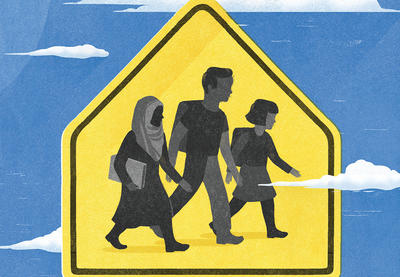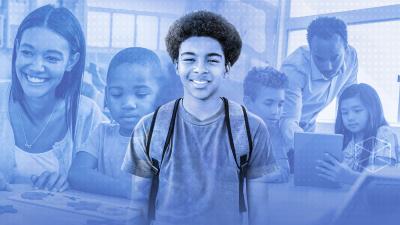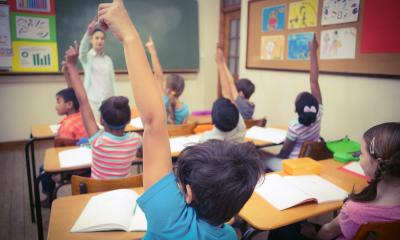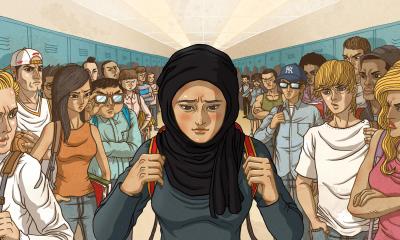In 2010, Hanif Mohebi approached the San Diego Unified School District, concerned about reports his office was receiving about the bullying of American Muslim students. The executive director of the San Diego chapter of the Council on American-Islamic Relations (CAIR), Mohebi was puzzled at first when the district found few reports of anti-Muslim bias or harassment among its data. But it did not take long for him to realize that the lack of data wasn’t due to a lack of bullying; Muslim kids weren’t reporting the abuse.
Over the course of the next six years, the California offices of CAIR launched a campaign to support kids and parents in reporting incidents of anti-Muslim bullying and bias to school administrators. They created a kid-friendly pocket guide to help students identify various forms of bullying and how to report them. They even surveyed more than 600 students, ages 11–18, publishing their findings in 2015. The findings included:
- 55 percent of Muslim students surveyed reported experiencing some form of bullying related to their religious identity;
- 29 percent of girls who wear a hijab—the traditional Muslim head scarf—said they had been offensively touched by another student;
- 20 percent of Muslim students said they had experienced discrimination by school staff.
One student responding to the survey said, “Telling any school faculty would have worsened the situation for me because they mostly have the same opinion of Muslims
[as the bullying students].”
With these facts in hand, CAIR returned to the district—and the district listened. On July 26, 2016, the school board met to consider a resolution to address Islamophobia in San Diego’s public schools. The auditorium was filled with more than 200 members and supporters of the local Muslim community, some holding small green signs that read “Protect Our Kids.” Students from elementary through high school lined up at the microphone to tell how they’d been called “terrorists,” had their hijabs yanked, and been threatened and physically assaulted.
District leaders across the country are recognizing that religious literacy not only counters anti-Muslim bias—it makes schools safer for everyone.
“I’d heard it all before, but I was in tears,” Mohebi says. Board Vice President Richard Barrera told the students, “You’re actually leading us. The young people who spoke here tonight, you’re right now making our society better, and making our school system better.”
When the board then voted unanimously to create a plan to address Islamophobia and the bullying of Muslim students, the audience broke into applause.
Who’s Vulnerable?
CAIR’s California surveys and other studies like it make it abundantly clear that Muslim students are under threat from their peers, not the other way around. Fifty-five percent of Muslim K–12 students surveyed say they experienced identity-based bullying. (Nationally, about 22 percent of all students report being bullied.) Individuals perceived to be Muslim—including Sikhs, Hindus and people of Middle Eastern and South Asian descent who are not Muslim—are often targets for abuse as well.
Many district officials are only beginning to understand the bias their Muslim students encounter. “Unless a school has a specific policy in place to deal with these kinds of bias, bias incidents against these groups will only become exacerbated over time,” says Mariam Durrani, an anthropologist and postdoctoral fellow at the Harvard Graduate School of Education.
Durrani and other scholars who study Islamophobia in the United States contend that the most effective school-based approaches address anti-Muslim bias specifically and emphasize religious literacy. This means training staff members to recognize forms of anti-Muslim bias in schools, updating the curriculum and upgrading school policies to ensure all religious groups feel respected and supported.
“In my experience, many non-Muslim teachers have questions about Islam but they don’t know how to ask them,” says Christine Sleeter, a curriculum specialist and professor emerita at California State University, Monterey Bay. “But they must educate themselves. Otherwise they will be afraid to address anything regarding religion.”
What's it like to be a Muslim student in the United States? We asked four young people from across the country for their perspectives.
Integrating Islam
One of the most comprehensive efforts to address Islamophobia can be found in the Montgomery County Public School District (MCPS) in Maryland. MCPS is the largest and most diverse district in the state. According to Farhana N. Shah, an MCPS English-language content specialist, some two-dozen languages are spoken in the district. Shah is also a member of the Working Group Education Subcommittee of the interfaith Montgomery County Faith Committee. The group collaborates with the district on curriculum, school policy and school climate.
The administration has also encouraged more integrated curricula. Last year Chris Murray, a social studies teacher at Walter Johnson High School in Bethesda, Maryland, revamped the Islam unit of his world religions class (an elective available to juniors and seniors) to tackle some of the most daunting issues related to anti-Muslim attitudes.
“"We look at Islam from three different perspectives: history, violent extremism and Islamophobia,” says Murray, who serves with Shah on the interfaith education committee. The history of Islam acts as the introduction, he explains, helping students get a handle on vocabulary and context. The course then pivots to violent extremism—who and where such groups are, their motivations, and how they compare to extremists in other major religions, including Christianity. Finally, students examine how the public’s views of Islam are shaped by popular media. They learn to identify the agendas of the “Islamophobia industry”: commentators, politicians and media outlets that profit by stoking fears about Muslims.
Teachers of younger students or those who teach subjects other than social studies and history can also play a part in developing religious and cultural literacy that includes Islam, adds Murray. Math teachers can share the formative role of Islamic scholars in the development of algebra, for example, while art instructors can compare and contrast the design elements in religious art and architecture among different faiths.
Efforts to promote religious literacy can have a positive influence beyond the classroom. Christine Zaccardi, a media specialist at Fox Road Magnet Elementary in Raleigh, North Carolina, has seen firsthand the value of diversifying the school’s library to include books about Islam. She recalls the time a kindergartener—an immigrant from Iraq—came to her clutching Golden Domes and Silver Lanterns: A Muslim Book of Colors to her chest. “This is about myw religion!” she told Zaccardi. The next day, the girl’s older sister stopped by and asked if there were other books about Islam, and later helped create a book display in honor of Arab American Heritage Month. Soon their mother was volunteering in the library.
Policy and Climate
In its 13-page booklet Guidelines for Respecting Religious Diversity, Montgomery County Public Schools outlines clear explanations of what in-school religious expression can and cannot look like. Topics range from “Distributing Religious Informational Materials” to “Religion-related Dietary Restrictions and Fasting.” The booklet features a Frequently Asked Questions section that explains what religious accommodations are available and acceptable, including in-school prayer.
As in most U.S. districts, Montgomery County’s code of conduct specifically articulates that bullying based on religion is grounds for disciplinary action. For teachers, the nuts and bolts of identifying and constructively dealing with bullying related to religious identity is now a topic the district addresses in its professional development programming. Montgomery County also has an online system where students can report incidents anonymously. The school culture and the PD facilitators encourage teachers to communicate with students about these incidents before they evolve into ongoing problems.
“I always have our speakers speak about issues in the classroom that they see and know of and how those acts manifest,” says Murray, who is active in planning PDs related to religious literacy. “Today in [PD] class I had two Sikh men speak about their own experiences and what kids today are facing. Last night, the Hindu American Foundation shared their report on bullying with our 30 teachers. We will have two days on Islam, both addressing acts of bullying and why they exist.”
Such policies and programs, paired with a more inclusive curriculum, can positively influence school safety and promote respect in the school community. School climate is formed by thousands of formal and informal interactions that occur every day. Even seemingly insignificant exchanges feed into it, especially for vulnerable groups such as Muslims. “A teacher pronouncing a student’s name correctly can be an important moment,” says Durrani.
Religious literacy also helps protect teachers from bias incidents. “If the school has a no-hats-in-school policy, but I know the student is wearing a yarmulke, I know not to say anything,” says Shah. “If I know the religious piece of it, then I’m not going to embarrass or offend the student.”
Senior Matthew Aghili, 18, has been a target of anti-Muslim harassment in other settings, and has seen Muslim friends insulted and assaulted. But he says he sees less of it at Walter Johnson High School. “The curriculum helps by encouraging understanding about others’ beliefs and not judging those beliefs or what students wear to school,” he says. He also credits teachers like Murray, who communicate in direct and indirect ways that they are allies of all students and are ready to offer support.
Religious Literacy vs. Islamophobia
According to the Pew Research Center, nearly half of Americans report not knowing anyone Muslim. Exposure to the lived experiences of American Muslims is an important step in stimulating religious understanding among staff members and students. Exposure can take the form of guest speakers, interfaith panels and a growing number of quality multimedia resources. In many communities, Muslims and interfaith activists are doing their part, as more mosques, universities and interfaith organizations now offer outreach programs to help educators explore their own questions about Islam and feel more confident with Islam-related content.
The goal is to remove the label of “other” from Muslims by helping people recognize all they have in common with their Muslim neighbors, colleagues and classmates. “Whether it’s students or teachers, there is nothing more powerful than actually experiencing communication, in this case between the Muslim community and people with little experience with Muslims,” says Mohebi.
Advocates seeking to counter anti-Muslim bias widely attest to the value of educating educators when it comes to religious literacy, Islam and Islamophobia. Says Mohebi, “When I do teacher trainings, the most common remark I get afterward is, ‘I wish I’d had this information before.’”
Resources for Teaching Religious Literacy
Religious Diversity in the Classroom, a free webinar series produced by Teaching Tolerance and the Tanenbaum Center for Interreligious Understanding, examines how teaching about religion across grade levels and subject areas can help meet academic standards.
Unity Productions Foundation offers films and accompanying educational materials “aimed at increasing understanding ... especially among Muslims and other faiths.”
The Bridge Initiative offers a wealth of research about the forces that perpetuate Islamophobia and practical suggestions for how to counter them.
“Dismantling Islamophobia,” an article published by Harvard Graduate School of Education’s online resource Usable Knowledge, offers six concrete ways to combat anti-Muslim bullying in schools.





1 COMMENTS